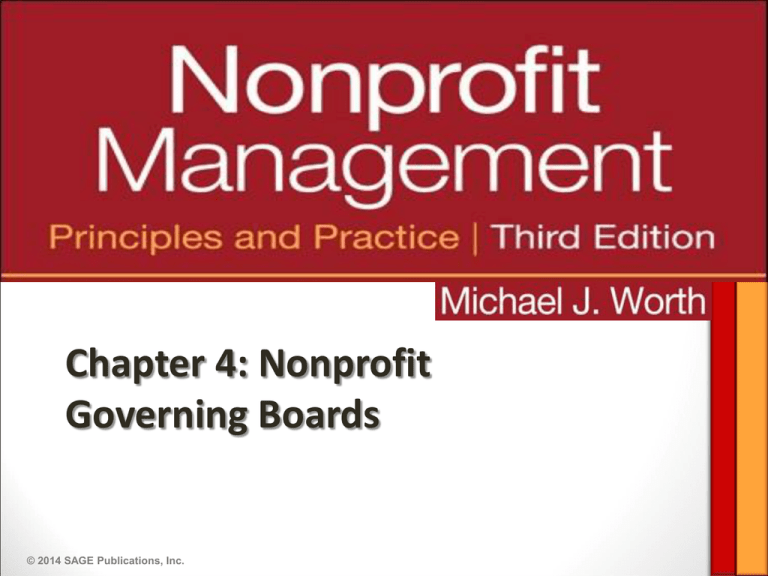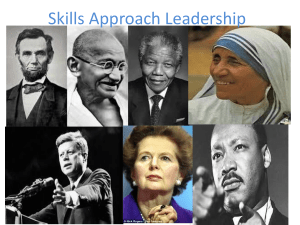Board Responsibilities - masonnonprofitfellows
advertisement

Chapter 4: Nonprofit Governing Boards © 2014 SAGE Publications, Inc. Terminology • Governing boards -- boards that hold ultimate responsibility for ensuring that the organization serves its mission and for the overall welfare of the organization itself • Terminology depends on specific organization • Board of directors • Board of trustees • Board of governors • Governing council • Other terminology • Boards that lack legal responsibility for governing their organizations are not governing boards (e.g., advisory boards) © 2014 SAGE Publications, Inc. Types of Governing Boards Elected boards • Common in member-serving and advocacy organizations • Governing board elected by the membership of the organization; can lead to a “popularity contest” • Membership terms of an elected board may be brief/turnover • Skills of board members may be uneven • CEO must have a high tolerance for uncertainty • Board members less likely to become stale, uninvolved or homogeneous in their membership © 2014 SAGE Publications, Inc. Types of Governing Boards Self-perpetuating boards • New members are selected by the existing members of the board who recruit them according to criteria established by the board • In a new nonprofit, the initial board members are known as “founding board members” who then develop bylaws, etc., which outline how the organization will be governed • Creates a relatively stable situation for the organization and its CEO as board members change less frequently; boards recruit new members with skills/expertise needed at the time • Board needs to maintain diversity to guard against becoming homogeneous © 2014 SAGE Publications, Inc. Types of Governing Boards Appointed and hybrid boards • A typical model for public organizations such as universities • Members selected through appointment by some authority such as the governor of a state, etc. • In hybrid boards, some members may be elected and some appointed or serving ex-officio • Hybrid boards can keep organizations responsive to their constituencies as well as better accountability • Appointed or hybrid board members may lack the commitment to the organization and may not fully participate in the work © 2014 SAGE Publications, Inc. © 2014 SAGE Publications, Inc. Advisory Boards & Councils • Better term should be “councils” rather than “advisory boards” to avoid confusion with governing boards • Have no legal responsibility or authority for governance of an organization • Members may provide a nonprofit with technical assistance/expertise, assist with fundraising activities, serve as advocates or ambassadors in the community • May or may not be formally established in the nonprofit’s bylaws • Role and parameters should be formalized with guidelines that outline the responsibilities of the council, etc. © 2014 SAGE Publications, Inc. Board Responsibilities • Board members are “fiduciaries of the organization’s resources and guardians of its mission” (Hopkins, 2003, p. 1) • Board members are accountable “for everything the organization does and how those things are accomplished” (Howe, 2002, p. 30) © 2014 SAGE Publications, Inc. Board Responsibilities: Legal • The Sibley Hospital Case (1974) • Care – exercising due diligence in monitoring and supervision • Loyalty – members put the interests of the nonprofit above their own personal financial interests • Obedience – members ensure that the organization complies with all laws and actions are consistent with the mission • Intermediate sanctions (1996) • Sarbanes-Oxley Act (2002) • Destruction of documents • Protection for whistle-blowers • Form 990 © 2014 SAGE Publications, Inc. Board Responsibilities: Functional • Appoint, support, and evaluate the CEO • Establish a clear institutional mission and purpose • Approve the organization’s programs • Ensure sound financial management and the organization’s financial stability • Establish standards for organizational performance and hold the organization accountable © 2014 SAGE Publications, Inc. The Board and the CEO • Who leads the nonprofit organization? • Extreme scenario 1 -- CEO manipulates the board, orchestrates board meetings, and relegates the board to the role of a rubber stamp for his or her initiatives • Extreme scenario 2 -- Board micromanages the organization and usurps the authority of the CEO • Partnership between the board and the CEO as ideal, but different views on exactly how this partnership should be constructed and how it should operate © 2014 SAGE Publications, Inc. Three Models of Board-CEO Relationship • Policy Governance Model (Carver, 1990) -- need to establish and enforce a clear line between the board’s responsibility for policy making and the executive’s responsibility for implementation • Governance as Leadership (Chait, Ryan, and Taylor, 2005) -- board should assume a leadership role that blurs the distinction between policy and implementation, focusing everyone’s attention on “what matters most” • "Psychological Centrality and Board-Centered Leadership (Herman and Heimovics, 2005) -- CEOs should accept the reality of their “psychological centrality” in the organization and provide “boardcentered leadership” © 2014 SAGE Publications, Inc. “Twelve Principles that Power Exceptional Boards” • • • • • • • • • • • • Constructive partnership Mission driven Strategic thinking Culture of inquiry Independent-mindedness Ethos of transparency Compliance with integrity Sustaining resources Results-oriented Intentional board practices Continuous learning Revitalization © 2014 SAGE Publications, Inc. Source: Board Source, 2005 Problems with Measuring Board Effectiveness • Reliance on practitioner wisdom rather than science • Lack of a substantial body of research on nonprofit board performance • Lack of a single definition of board effectiveness Board effectiveness is “whatever significant stakeholders think it is, and there is no single objective reality"(Herman and Renz, 2002) © 2014 SAGE Publications, Inc. The Challenge of Nonprofit Governance • Janus metaphor -- nonprofit boards are positioned on the boundary between the organization and its external environment • Inward-looking role in fulfilling fiduciary responsibilities on behalf of the membership or society • Outward-looking role in meeting responsibilities to the organization itself and advance its interests • Complex responsibilities require diverse qualities in the individuals selected to serve on the board © 2014 SAGE Publications, Inc. The Board’s Sometimes Competing Responsibilities To Society • Accountability for resources and results • Adherence to mission and law • Representation of community needs © 2014 SAGE Publications, Inc. To the Organization • Advocacy and authenticity • Protection of autonomy • Fiscal stability and sustainability Chapter 5: Executive Leadership © 2014 SAGE Publications, Inc. CEO Responsibilities • • • • • • • • • • Commit to the mission Lead the staff and manage the organization Exercise responsible financial stewardship Lead and manage fund-raising Follow the highest ethical standards, ensure accountability, and comply with the law Engage the board in planning and lead implementation Develop future leadership Build external relationships and serve as an advocate Ensure the quality and effectiveness of programs Support the board © 2014 SAGE Publications, Inc. Source: Board Source, 2006 Observations About CEO Responsibilities • Significant overlap between CEO responsibilities and governing board responsibilities • Mission, financial stewardship, fund-raising, accountability, planning, performance standards, and the work of the board itself • CEO responsibilities involve both managing and leading • Management -- generally concerned with day-today operations, emphasizing policies, procedures, rules, and processes • Leadership -- more about purpose, vision, and direction: more about the “where” and “why” rather than the “how” © 2014 SAGE Publications, Inc. Managers and Leaders Managers Leaders • Concerned with mastering routines • Adopt impersonal or passive attitudes toward goals • Excel in problem solving and work design • Work with people in carefully controlled ways • See themselves as conservators or regulators • Concerned with vision and judgment • Active and visionary about the future • Seek out opportunities and take risks • Passionate about their work and likely to cause turbulence • See themselves as agents of change © 2014 SAGE Publications, Inc. Leadership Theories: Introduction • Key questions • Are leaders born or made? • If they are made, what specific knowledge or skills do individuals need to acquire in order to be strong leaders? • What are there specific behaviors that are associated with effective leadership? • Key caveats • Most of the theories are generic (i.e., intended to apply to all types of organizations, not just nonprofits) • There may be no one right theory of leadership that is applicable in every situation, at all times © 2014 SAGE Publications, Inc. Leadership Theories: Overview • Trait theories -- emphasis on innate characteristics of leaders • Skills theories -- emphasis on specific skills leaders possess • Technical skills – knowledge of the job/profession/task • Human skills – ability to work with people • Conceptual skills – ability to understand ideas and principles • Behavior theories -- emphasis on behavior or actions • Task behaviors – actions that relate to the work to be done • Relationship behaviors – actions that focus on the feelings of subordinates • Managerial grid (Blake and Mouton, 1985) • Contingency theories -- emphasis on the situation • Servant leadership -- emphasis on values and commitment © 2014 SAGE Publications, Inc. Transformational Leadership • Transactional leadership – rewards or punishment exchanged for behaviors of others • Transformational leadership -- inspiring and empowering individuals to go beyond self-interest and pursue goals that are in the common interest • Emphasis on developing personal relationships • Appealing to shared values and ideals • Transactional versus transformational leadership (Burns, 1978) • Transformational leaders use transactional techniques, but should not overemphasize them (Bass, 1985; Bass and Avolio, 1994) © 2014 SAGE Publications, Inc. Charismatic Leadership • A leader is someone who behaves in certain ways that cause others to see him or her as charismatic • Behaviors that cause others to see a person as charismatic (Rainey, 2003) • Advocates a vision that is different from the status quo but still acceptable to followers • Acts in unconventional ways in pursuit of the vision • Engages in self-sacrifice and risk taking in pursuit of the vision • Displays confidence in his or her own ideas and proposals • Uses visioning and persuasive appeals to influence followers, rather than relying mainly on formal authority • Uses the capacity to assess context and locate opportunities for novel strategies • Need for social distance (Fisher, 1984) © 2014 SAGE Publications, Inc. Effective Nonprofit CEO Behaviors • • • • • • • Focus on mission Focus on the board Focus on external relationships Share leadership and empower others Focus on key roles and priorities Use the “political frame” Right person, right place, right time • Alignment model (Dym & Hutson, 2005) • Founder syndrome and life-cycle theories • Executive transitions and leading change © 2014 SAGE Publications, Inc. Right Person, Right Place, Right Time Alignment Model • Seeks to integrate the major leadership theories • The leader’s fit with the organization involves traits, skills, leadership style and situation • Alignment must be achieved between the leader, the organization, and the community Founder Syndrome • Organization’s need for leadership may change over time due to nature of nonprofit life-cycle theories • Can pose challenge and even crisis for a nonprofit Executive Transitions • Preparation should take place before a transition is needed • Viable plan and procedure to be proactive vs. reactive © 2014 SAGE Publications, Inc. Leading Change Eight-step change process to ensure momentum and provide for real and permanent change: 1. Establish a sense of urgency 2. Create a guiding coalition 3. Develop a vision and strategy 4. Communicate the change vision 5. Empower broad-based action 6. Generate short-term wins 7. Consolidate gains and produce more change 8. Anchor new approaches in the culture (Kotter 1996) © 2014 SAGE Publications, Inc.







